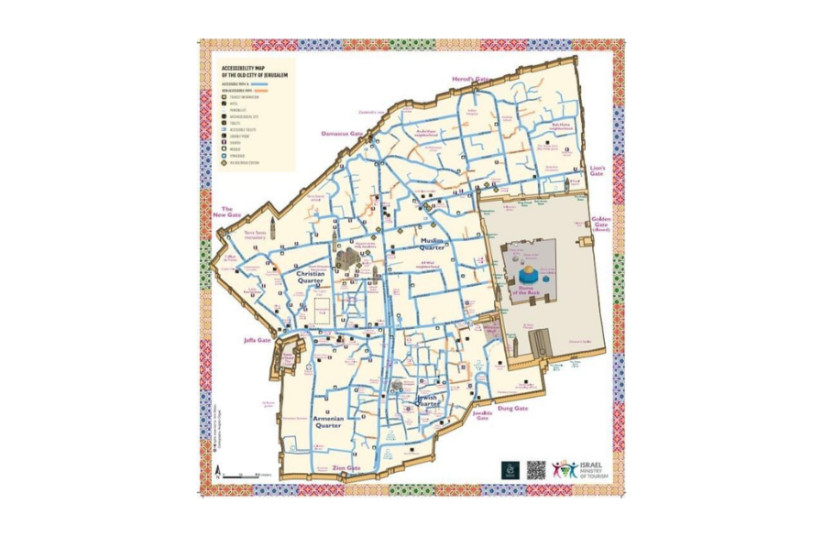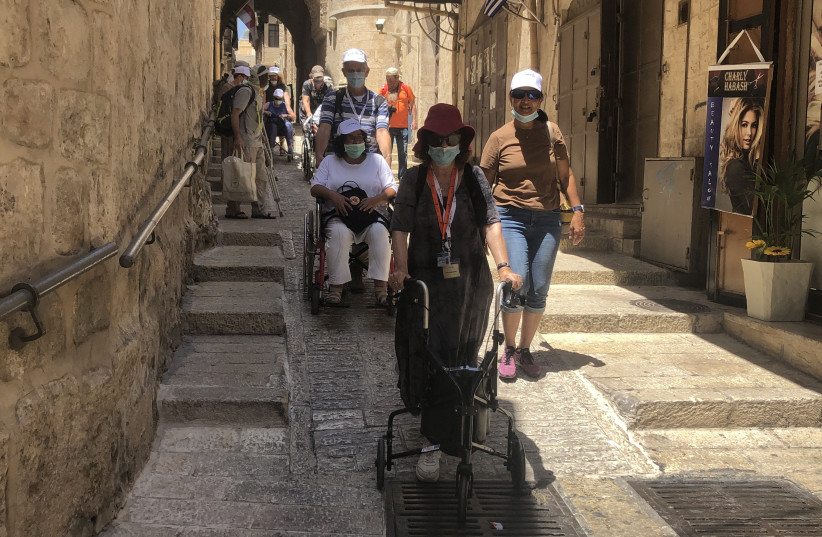As Israel’s skies finally opened up to tourists six weeks ago for the first time since the Covid-19 pandemic began, the final touches were being completed on making the Old City accessible not only to wheelchairs and baby strollers but also to mini-ambulances and mini-garbage trucks, all to improve the quality of life for residents.
After a decade of work and an investment of more than NIS 22 million, the accessibility of the sixth kilometer in the alleys of the Old City of Jerusalem was completed just in time for the many visitors expected during the upcoming Easter, Ramadan and Passover holidays.
It took 10 years for the first four kilometers of the Accessible Jerusalem-Old City project to be complete because of the complexity of working within the one square kilometer historical area, where both the city and its walls are a designated UNESCO World Heritage site, in which its local residents live their daily lives and to which millions of visitors ascend each year, noted Gura Burger, spokeswoman for the East Jerusalem Development Company (PMI) which implemented the program.
The Old City’s UNESCO designation requires that any physical change be accompanied by monitoring and conservation teams.
“We want to make the public areas of the Old City graceful to the people who live here and to make the city graceful for the people who visit,” said Berger, noting that by making the Old City accessible many more pilgrims and tourists will be able to visit. “When people come to Jerusalem they are looking for grace.”

Built on five hills, the dramatic height difference in the Old City of about 80 meters at the highest point at New Gate and the lowest point at Dung Gate, and the thousands of steps built over the generations now needing to be made accessible, also added to the complexity of the project.
Then the Covid-19 pandemic hit and they decided to make lemonade from the lemons as a rare opportunity arose to quickly complete the accessibility of the sixth kilometer on David Street including the market, from Jaffa-Omar Ibn al-Khattab Gate through Chain Street to the Temple Mount, and the last section of the Via Dolorosa.
“We worked day and night and we made two kilometers accessible in two years,” Berger said. “These are the most sentimental kilometers because for the first time in history the Via Dolorosa is accessible. We did something important because people really come here in awe, with respect and in hope to the holy city.”
The steep slope along the last stretch of the Via Dolorosa near the fifth, sixth and seventh stations required the use of “Venetian stairs,” which combines short sloping steps within the ramp. Maneuvering it is still an effort, Berger admitted, but in some instances such as this solutions are limited because of the historical and topographical aspect of the city. However, she said, now that 95% of the city has been made accessible they are in a continuous process of reviewing the infrastructure, listening to the residents and making as many improvements as possible.
“Compared to what it was, this is excellent,” said Nael Bader, whose jewelry store is located on the Via Dolorosa.
The whole accessibility project was carried out under the leadership of the Ministry of Jerusalem and Heritage in cooperation with the Ministry of Tourism, the Jerusalem Municipality, the Israel Antiquities Authority, the Jerusalem Development Authority and the East Jerusalem Development Corporation.

The project included renewing pavement, replacing underground infrastructure, including sewage; planning and building accessibility ramps, painting facades, awnings, adjusting air conditioners, cabling and arranging entrances to shops and residences, which each required individual planning because of their different circumstances.
In a few places handrails have been added along the walls because of the slope of the street and there are now 14 accessible toilet facilities with signs throughout the Old City.
The planning stage of the project took five years and involved numerous mappings of the Old City, including measuring every individual step.
The Old City walls were built as a citadel to guard the city, and originally there was a moat in the natural wadi at the Jaffa Gate entrance, noted Berger, blocking people from arriving other than by foot.
“But now we want to make it an accessible city and it required rethinking,” she said. “We are doing it in a very minor way. We don’t want to ruin the historical patina of the Old City. We don’t want people to notice what we have done, but to feel it is pleasant; our work is in the background.”
In 1898 under the Ottoman rulers the first step toward accessibility was taken for the celebrated visit of German Kaiser Wilhelm II and his wife the Empress Augusta Victoria. The moat was filled in so the royal couple would be able to ride in a carriage into the Old City, and the empress would not have to dirty her shoes or the hems of her dress.
The Accessible Jerusalem-Old City project began in the Muslim Quarter at the Lions Gate, where the need was greatest. Many elderly people and people with disabilities, including children, were unable to maneuver around the Old City streets, said Berger. Ambulances, fire trucks and garbage disposal trucks were not able come into the Old City.
“We started with the needs of the local people. We asked them what they needed, and they said to be able to get out of the Old City. Before, if someone had a heart attack in the middle of the Muslim Quarter they needed to be carried up 50 meters to get help,” said Berger.
The project also includes an Accessible Jerusalem app (Accessible JLM-Old City) in nine different languages which maps out the accessible routes within the Old City. Visitors can download it even before arriving, making it easier for both groups and individual families to map out their route.
In addition, some 60 beacons of a planned 200 have been installed throughout the city to orient people with visual impairment. The beacons use bluetooth connection and are not internet-dependent because of the difficulty of connectivity in the Old City. The beacons are automatically accessed through the downloadable Step-Hear app which for now is only available in Hebrew and English, but other languages are in the planning.
Entrances to the Western Wall, the Church of the Holy Sepulcher and the Temple Mount/Haram al-Sharif have also been made accessible – but the sites themselves are private property and are not under the domain of the project.
Some things, like the large ancient Roman pavement stones in the Christian Quarter have not been touched.
The accessibility work has made a difference for the older people of the neighborhood, said Old City resident Razi Rasheq.
“My neighbors suffered because every time they needed an ambulance it wasn’t able to reach them,” Rasheq said.
The work has also allowed for private entrepreneurship and now there are four small club cars – similar to golf carts – which function as taxis within the old city ferrying people from one point to another.
“I pick up old people and can take them anywhere in the Old City. They know they can call me and I will come,” said club car driver Ali Karkash, driving up to Jaffa Gate. “Anyone can call me. I am always here.”
